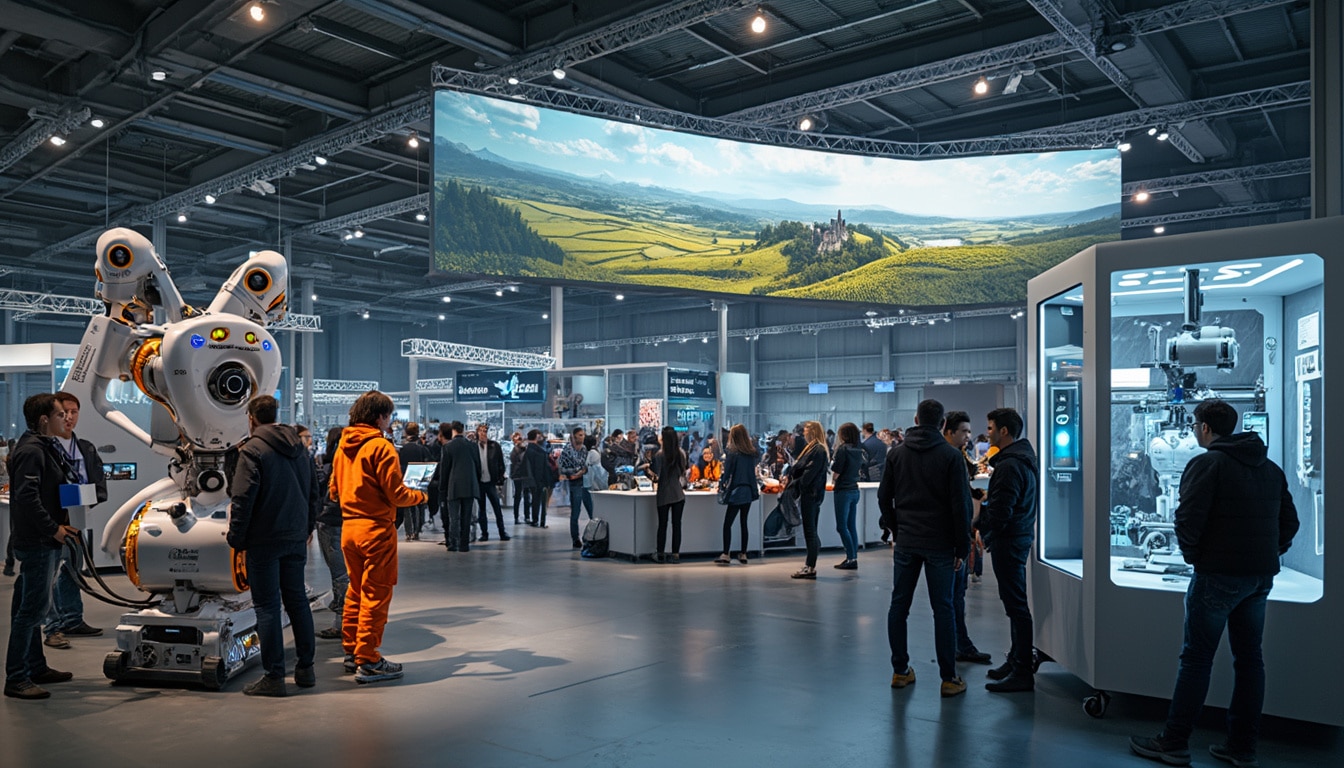Innovation and tradition dance a delicate tango in the culinary world.Chef Thierry Marx champions this harmonious blend, ensuring that timeless recipes evolve without losing their essence.It’s a balancing act that keeps kitchens both grounded and forward-thinking.
In the bustling realm of gastronomy, innovation isn’t just a buzzword—it’s the secret ingredient that propels chefs beyond the confines of traditional cookery. Thierry Marx, a luminary in the culinary arts, often intertwines innovation with tradition, arguing that without fresh ideas, age-old recipes would remain stagnant relics. Collaborating with researcher Raphaël Haumont, Marx co-founded the French Culinary Innovation Center at the University of Paris Saclay, where the future of cooking is being meticulously crafted. Here, the team doesn’t just tweak recipes; they revolutionize the very tools of the trade, developing next-generation cookware that responds to the latest culinary breakthroughs. Beyond equipment, Haumont delves into the science of food states—liquid, gaseous, solid—to concoct dishes that surprise and delight the palate. Cooking, they assert, is undeniably a science, where precise temperatures can mean the difference between a perfectly poached egg and a culinary catastrophe. Embracing innovation also means welcoming failure, as each experimental dish is a step towards culinary mastery. In a high-stakes environment like a restaurant, where consistency is key, the courage to innovate sets true culinary pioneers apart from the rest.
Exploring the intersection of science and art, the team at Saclay tackles challenges that most chefs might sidestep. By understanding the molecular transformations that occur during cooking, they can manipulate textures and flavors with surgical precision. For instance, knowing that a bean reaches its ideal texture at exactly 82°C allows chefs to achieve perfection every time. This meticulous approach transforms the kitchen into a laboratory, where creativity meets exactitude.
However, the path of innovation is fraught with risks. Establishing new cooking methods or combining unexpected ingredients can lead to unforeseen failures. Yet, it’s through these missteps that breakthroughs occur. Marx emphasizes that without the willingness to experiment and accept mistakes, the culinary world would stagnate, missing out on potential masterpieces born from trial and error.
In the fast-paced environment of a restaurant, the pressure to deliver consistent results can stifle creativity. Restaurateurs must balance the demand for reliability with the desire to push culinary boundaries. While innovation can be seen as a gamble, it is also the catalyst for evolution in dining experiences, challenging both chefs and patrons to embrace the new while respecting the old.
The collaboration between chefs and scientists illustrates a groundbreaking approach to cooking, where tradition serves as the foundation upon which innovation builds. This synergy not only enhances the dining experience but also paves the way for sustainable and efficient culinary practices. As the culinary landscape continues to evolve, the marriage of tradition and innovation will remain essential in shaping the future of food.

Table of contents
Togglewhat drives culinary innovation today?
Culinary innovation is fueled by a dynamic interplay between tradition and modernity. As renowned chef Thierry Marx aptly states, “Tradition is a benchmark, but traditions would remain static without innovation.” This philosophy underscores the necessity of evolving classic recipes and techniques to keep pace with changing tastes and technological advancements. In today’s fast-paced world, chefs and culinary experts are constantly seeking new ways to enhance flavors, textures, and presentation, making the kitchen a hub of continuous experimentation and creativity.
The push for innovation is also driven by consumer demand for unique and personalized dining experiences. Modern diners are more adventurous, seeking out novel ingredients and innovative cooking methods that offer something beyond the conventional meal. This shift has prompted chefs to explore fusion cuisines, incorporating elements from different culinary traditions to create exciting new dishes. Additionally, the rise of food media and social platforms has amplified the reach of innovative culinary creations, encouraging chefs to think outside the box to capture the attention of a global audience.
Moreover, sustainability and health consciousness are significant motivators for culinary innovation. With increasing awareness of environmental impact and nutritional well-being, there is a growing emphasis on sustainable sourcing, reducing food waste, and creating dishes that are both delicious and healthful. This has led to the development of plant-based alternatives, the use of locally sourced ingredients, and the implementation of eco-friendly kitchen practices. By addressing these contemporary concerns, culinary innovation not only satisfies taste buds but also aligns with broader societal values.
In essence, the drive behind culinary innovation is multifaceted, encompassing the desire to honor tradition while embracing new ideas, meeting evolving consumer preferences, and addressing global challenges. This delicate balance ensures that the culinary arts remain vibrant, relevant, and continuously advancing.
how technology is transforming kitchen practices
The integration of technology into the kitchen has revolutionized traditional cooking practices, making culinary processes more efficient, precise, and creative. One of the most significant advancements is the rise of smart kitchen appliances. These devices, equipped with internet connectivity and advanced sensors, allow for greater control and automation in cooking. For instance, smart ovens can be programmed to maintain exact temperatures, ensuring consistent results every time, while smart refrigerators can monitor inventory levels and suggest recipes based on available ingredients.
Artificial Intelligence (AI) plays a pivotal role in transforming kitchen practices. AI-powered tools assist chefs in recipe development by analyzing vast amounts of data to identify flavor combinations and cooking techniques that resonate with contemporary tastes. Additionally, AI can predict trends, helping chefs stay ahead of the curve in culinary innovation. Platforms like AI-assisted reverse engineering is an innovation we’re unable to grasp truly desirable highlight how AI is being leveraged to deconstruct and recreate dishes, pushing the boundaries of what’s possible in the kitchen.
Moreover, advancements in robotics are beginning to make their mark in professional kitchens. Robotic sous-chefs can perform repetitive tasks with precision, allowing human chefs to focus on more complex and creative aspects of cooking. This not only enhances productivity but also minimizes the risk of human error, leading to more consistent and high-quality dishes.
Another transformative technology is augmented reality (AR), which provides interactive and immersive experiences in culinary education and training. AR can overlay instructional guides and real-time feedback onto the cooking environment, making it easier for chefs to learn new techniques and improve their skills. This technology is particularly beneficial in high-pressure kitchen settings, where quick learning and adaptability are crucial.
Incorporating these technological advancements into kitchen practices not only streamlines operations but also fosters a culture of innovation and continuous improvement. As technology continues to evolve, its impact on the culinary world will undoubtedly deepen, opening up new possibilities for chefs and food enthusiasts alike.
the role of scientific research in modern cooking
Scientific research plays a crucial role in modern cooking, bridging the gap between culinary arts and food science to create innovative and sophisticated dishes. At the forefront of this integration is the Centre français d’innovation culinaire at the University of Paris Saclay, co-founded by chef Thierry Marx and researcher Raphaël Haumont. This research center collaborates with equipment manufacturers to design the kitchens of the future, incorporating the latest scientific discoveries into culinary practices.
One of the key areas of focus at the center is the study of different states of matter—liquid, gaseous, solid—and their interactions in the culinary process. Understanding how ingredients behave under various conditions allows chefs to craft dishes with precise textures and flavors. For example, mastering the exact temperatures needed to cook a perfect egg or achieve the ideal doneness of a veal roast requires meticulous scientific analysis, as Thierry Marx emphasizes: “Cooking an egg is about protein reactions, matter hardens, and aromas develop with scientific precision.”
The collaboration between chefs and scientists facilitates the development of new cooking techniques and equipment. Researchers work on creating innovative kitchen tools that enhance the efficiency and creativity of chefs, enabling them to experiment with new methods of preparation and presentation. This synergy not only advances the culinary arts but also contributes to the broader field of food technology, with applications that extend beyond professional kitchens to home cooking.
Furthermore, scientific research contributes to the understanding of nutrition and food safety, ensuring that culinary innovations are not only creative but also healthy and safe for consumption. By studying the nutritional profiles of ingredients and the effects of different cooking methods on food quality, researchers help chefs create dishes that meet the growing demand for nutritious and responsibly prepared meals.
In summary, scientific research is integral to modern cooking, providing the knowledge and tools necessary for culinary innovation. The collaboration between chefs and scientists drives the evolution of the culinary arts, leading to the creation of dishes that are both scientifically grounded and artistically inspired.
examples of cutting-edge kitchen technologies
The culinary world is witnessing a surge in cutting-edge kitchen technologies that are redefining how food is prepared, cooked, and presented. These innovations range from advanced cooking appliances to sophisticated software solutions, each contributing to increased efficiency, precision, and creativity in the kitchen.
One notable example is the development of precision cookers, such as sous-vide machines, which allow chefs to cook food at exact temperatures for extended periods. This technique ensures consistent results by controlling the cooking environment with unparalleled accuracy. Precision cookers are particularly useful for achieving specific textures and flavors, making them a staple in both professional and home kitchens.
Another groundbreaking technology is 3D food printing, which enables the creation of intricate and customized food designs that would be impossible to achieve by hand. This technology uses edible materials like chocolate, dough, and purees, layering them to form complex structures. 3D food printing opens up new possibilities for culinary artistry, allowing chefs to experiment with novel presentations and personalized nutrition.
Smart kitchen appliances are also revolutionizing culinary practices. For instance, smart refrigerators equipped with cameras and inventory tracking systems can monitor ingredient levels in real-time, suggest recipes based on available ingredients, and even reorder supplies automatically. Similarly, smart ovens with AI capabilities can adjust cooking times and temperatures on the fly, ensuring optimal results with minimal supervision.
Augmented Reality (AR) and Virtual Reality (VR) technologies are enhancing culinary education and training by providing immersive learning environments. Chefs can use AR to receive real-time guidance and feedback while cooking, while VR simulations offer hands-on experience in complex culinary techniques without the need for physical ingredients.
Furthermore, advancements in robotics are making their way into commercial kitchens. Robotic arms can handle repetitive tasks such as chopping, stirring, and plating, allowing human chefs to focus on more creative endeavors. These robots enhance efficiency and consistency, ensuring that each dish meets the highest standards of quality.
Lastly, AI-driven recipe development tools analyze vast datasets to identify emerging trends and optimal flavor combinations. These tools assist chefs in experimenting with new ingredients and techniques, fostering a culture of continuous innovation and experimentation in the kitchen.
These examples of cutting-edge kitchen technologies illustrate the profound impact of innovation on the culinary landscape. By embracing these advancements, chefs and food enthusiasts alike can elevate their culinary creations, pushing the boundaries of what is possible in the kitchen.
overcoming challenges in culinary innovation
While culinary innovation offers numerous benefits, it also presents a set of challenges that chefs and the food industry must navigate. One of the primary hurdles is the acceptance of failure as an inherent part of the innovation process. As Thierry Marx points out, experimenting with new cooking techniques or ingredient pairings often involves trial and error, and not every attempt will result in success. Embracing failure allows chefs to learn from their mistakes and refine their approaches, ultimately leading to more robust and inventive culinary creations.
Economic pressures are another significant challenge in culinary innovation. Restaurants and food businesses operate within tight budgets and face the constant need to deliver results that meet customer expectations. Investing in new technologies or experimenting with unconventional ingredients can be risky, potentially leading to financial loss if the innovations do not resonate with diners. Moreover, the fast-paced nature of the restaurant industry means that chefs must balance the desire to innovate with the necessity of maintaining consistent quality and service.
Regulatory and safety concerns also pose obstacles to culinary innovation. Introducing new ingredients or cooking methods may require compliance with food safety standards and regulations, which can vary by region and market. Ensuring that innovative dishes are safe for consumption is paramount, necessitating thorough testing and adherence to legal guidelines. This adds an additional layer of complexity to the innovation process, requiring collaboration between chefs, scientists, and regulatory bodies.
Additionally, there is the challenge of cultural resistance to change. Traditional culinary practices are deeply rooted in many cultures, and deviations from established norms can be met with skepticism or disapproval. Chefs striving to innovate must navigate these cultural sensitivities, finding ways to honor tradition while introducing novel concepts. This delicate balance is essential to gaining acceptance and appreciation for innovative dishes among diverse audiences.
To overcome these challenges, collaboration and continuous learning are crucial. Engaging with research institutions, like the Centre français d’innovation culinaire, and leveraging technological advancements can provide the support and resources needed to push the boundaries of culinary innovation. Furthermore, fostering a culture that values experimentation and resilience helps chefs and food businesses adapt to the evolving landscape, ensuring sustained growth and success in their innovative endeavors.
future trends in kitchen technology
The future of kitchen technology promises even more exciting advancements that will further transform the culinary landscape. As technology continues to evolve, several key trends are emerging that are set to redefine how we cook, dine, and interact with food.
One prominent trend is the integration of Internet of Things (IoT) devices in kitchens. Smart appliances interconnected through the IoT ecosystem will enable seamless communication and coordination, optimizing kitchen operations. For example, refrigerators could communicate with ovens to adjust cooking times based on ingredient availability, while smart dishwashers manage cleaning cycles automatically. This interconnectedness enhances efficiency and convenience, making kitchens smarter and more responsive to user needs.
Another significant trend is the advancement of personalized nutrition through technology. With the rise of health-conscious consumers, there is a growing demand for meals tailored to individual dietary requirements and preferences. AI-driven applications can analyze personal health data and suggest customized meal plans, ensuring that culinary creations align with nutritional goals. This personalization extends to ingredient sourcing and meal preparation, offering a more holistic approach to healthy eating.
Sustainable kitchen technologies are also gaining traction, reflecting the increasing emphasis on environmental responsibility. Innovations such as energy-efficient appliances, water-saving devices, and sustainable packaging solutions are becoming standard in modern kitchens. Additionally, technologies that enable the reduction of food waste, such as smart inventory management systems, help promote sustainability by ensuring that ingredients are used optimally and responsibly.
Augmented Reality (AR) and Virtual Reality (VR) will continue to play a significant role in culinary education and entertainment. Future kitchens could feature AR interfaces that provide interactive cooking guides, transforming the cooking experience into an engaging and educational activity. VR could offer virtual dining experiences, allowing users to explore global cuisines and cooking techniques from the comfort of their homes.
Advanced robotics will further enhance automation in kitchens. Future robots may possess greater dexterity and adaptability, capable of handling more complex cooking tasks and interacting safely with human chefs. This will not only improve efficiency but also open up new creative possibilities, as robots take on routine tasks and allow chefs to focus on innovation and artistry.
Lastly, the use of biotechnology in cooking is poised to revolutionize food preparation and ingredient sourcing. Innovations such as lab-grown meats, genetically modified ingredients for enhanced flavors, and fermentation technologies for novel food products are on the horizon. These biotechnological advancements will offer chefs new tools and ingredients, expanding the horizons of culinary creativity and sustainability.
As these trends continue to develop, the future of kitchen technology looks promising, with endless possibilities for culinary innovation. Embracing these advancements will empower chefs and home cooks alike to explore new dimensions of cooking, ensuring that the culinary arts remain vibrant, adaptive, and forward-thinking.
case studies in culinary innovation
Examining real-world examples of culinary innovation provides valuable insights into how technology and creativity intersect to push the boundaries of the culinary arts. These case studies highlight the practical applications of advanced technologies and the impact they have on the culinary landscape.
One notable case study is the collaboration between Thierry Marx and Raphaël Haumont at the Centre français d’innovation culinaire. Their joint efforts have led to the development of next-generation kitchen equipment, such as advanced cooking pans and ovens that incorporate the latest scientific discoveries. By working closely with equipment manufacturers, they have created tools that allow for greater precision and efficiency in the kitchen, enabling chefs to experiment with new cooking techniques and textures.
Another compelling example is the adoption of AI-assisted recipe development by leading restaurants. By leveraging AI tools, chefs can analyze vast datasets to identify emerging food trends and optimal flavor pairings. This technology facilitates the creation of innovative dishes that cater to evolving consumer preferences, ensuring that restaurants remain competitive and forward-thinking. The article AI-assisted reverse engineering is an innovation we’re unable to grasp truly desirable explores how AI is transforming the way chefs approach recipe creation and menu planning.
In the realm of sustainable culinary practices, some restaurants have implemented zero-waste kitchens by utilizing smart inventory management systems. These systems track ingredient usage in real-time, reducing food waste and optimizing procurement processes. By integrating technology that monitors stock levels and expiration dates, chefs can make informed decisions about ingredient usage, minimizing waste and enhancing sustainability.
The city of Grenoble serves as a hub of technological and scientific innovation in the culinary sector. As highlighted in Christophe Ferrari highlights Grenoble’s long-standing position as a hub of technological and scientific innovation, the region fosters a collaborative environment where chefs, scientists, and technologists work together to pioneer new culinary techniques and technologies. This collaborative spirit has led to breakthroughs in areas such as food preservation, flavor enhancement, and kitchen automation.
Additionally, initiatives like the Sarthe Innove awards celebrate and recognize outstanding innovations in the culinary field. Featuring nominees who have introduced groundbreaking technologies and techniques, these awards highlight the diverse ways in which innovation is shaping the future of cooking. The innovation category meet the nominees for Sarthe Innove showcases the ingenuity and creativity of chefs who are redefining culinary standards through technological advancements.
These case studies demonstrate the profound impact of innovation on the culinary arts, illustrating how technology and creativity can work hand in hand to create exceptional dining experiences. By learning from these examples, other chefs and culinary professionals can draw inspiration and adopt best practices to further advance their own innovative endeavors.














